Abstract
As the development of mountain areas has recently increased in Korea, existing roads are being renovated, and new highways are being constructed, which increases driving speeds in mountainous areas. However, the mountainous region in northeastern Korea is more likely to form black ice due to higher humidity, frequent fog, and hillshade, depending on the terrain, which can cause serious traffic pileups. In this study, therefore, we present a method to build a more effective black ice prediction and warning system by linking spatial information to the existing road management system that estimates the road surface temperature based on real-time weather information. The spatial information enabled a prediction to be made of the risk level of black ice formation for each time zone by simulating changes in the shadow area based on precise 3D terrain information. Moreover, this information also presented slope and curvature information of the road to estimate the risk zone. The spatial information was integrated with weather data to predict road surface temperature. The proposed system was tested in two mountainous regions with weather data accumulated from 2017 to 2018. As a result, the proposed system anticipated 71% of traffic accidents caused by black ice during the testing period. The results show that the system can contribute significantly to preventing black-ice-related traffic accidents by providing reasonable predictions.
1. Introduction
Since Korea has an average winter temperature of 0.5 °C and an average humidity of 65%, traffic accidents caused by snow and frost are frequent in the winter season. In particular, Korea has many mountainous areas and is surrounded by the sea on three sides, which often causes black ice on road surfaces around the mountains. Black ice is a thin coating of glazed ice on roadways or other transportation surfaces [1] and has an appearance that is identical to the black pavement and wet roads on which it forms [2]. Since the black ice is highly transparent and difficult to see, it causes fatal accidents in the winter season. Black ice is usually formed at night or in the early morning due to sudden temperature drops. This phenomenon is more pronounced on bridges and overpasses due to their elevated and exposed nature [3]. Black ice is more critical as the winter weather gets warmer. According to the Korea Transport Institute [4], the fatality rate of traffic accidents caused by black ice is highest, at 4.2%, when the temperature in winter is above 2 °C to 3 °C, but is lower, at 0.7%, when the temperature is between minus 1 °C and 0 °C. This is because black ice is created when there is increased water vapor due to higher air temperatures, which meets the cold road surface.
As the development of mountain areas has recently increased, several roads are being renovated, and new bridges and tunnels are constructed, leading to increased driving speeds. However, the mountainous areas of Korea, especially the area close to the sea, are more likely to incur black ice due to higher humidity and temperature change [3]. While traffic accidents have decreased due to the implementation of government policies, black ice accidents in winter are steadily increasing. Among the total traffic accidents in 2015, the proportion of traffic accidents due to black ice and snowfall was about 6%, but had increased to about 10% by 2018. For this reason, the need for research on black ice prediction and warning systems has been emerging.
With the recent development of sensor technology, research has been conducted to collect and utilize real-time weather information for each road section and road state information. Meteorological information monitoring systems are installed on national highways and major bridges. For example, the Korea Expressway Corporation has determined highway freeze sections and collected road freezing information and road weather forecasting information [5]. That information has been used for highway management. However, these monitoring systems are operated mainly for highways and major roads in urban areas. Meanwhile, most local roads along mountain areas are managed by local governments, so it is not economically feasible to apply the above systems. This study, therefore, aims to develop a risk assessment and warning system to prevent local traffic accidents caused by black ice by integrating spatial and meteorological information and local road networks. With the spatial information, the risk level of black ice for each time zone is estimated by simulating changes in the shadow area based on precise 3D terrain information. In addition, road structure information such as slope and curvature are considered for traffic accident risk assessment.
2. Related Works
2.1. Road Surface Temperature Forecast Model
In order to determine the possibility of black ice formation, a temperature prediction model of the road surface is required. Since the 1980s, several studies [6,7,8,9,10,11,12] predicting road surface temperatures and the occurrence of black ice have been presented. Shao and Lister [6] developed an automated road-ice-prediction model for the first time. This model used automatically collected sensor measurements of surface temperature, air temperature, dewpoint, and wind speed rather than external meteorological data. Sass [7] developed a model of ground heat conduction and energy balance to estimate road surface temperatures for a numerical forecasting system. This system was applied to 200 road station sites to provide a forecast of surface temperature five hours in advance. Crevier and Delage [8] also presented a numerical model to forecast road conditions, namely the model of the environment and temperature of roads (METRo). This model combined roadside observations from road weather information systems stations and meteorological forecasts from the operational Global Environmental Multiscale (GEM) model of the Canadian Meteorological Centre for use as input data. Kim [9] developed a road condition hazard map that could predict potential road hazards under various weather conditions. This was achieved by linking real-time meteorological and traffic information based on the accident analysis data for various weather factors. The meteorological data (i.e., precipitation amount, temperature, and average wind speed) were gathered with AWS (Automatic Weather System) and ASOS (Automated Surface Observation System) from the Meteorological Administration’s ground weather observation network. In Japan, where climate conditions are similar to those in Korea, several studies on black ice prediction have also been actively conducted [10,11,12]. However, the past studies described above lacked consideration of hillshade areas caused by the 3D shape of the topography.
2.2. Road Surface Temperature Forecast Considering the 3D Shape
More recently, several studies have emphasized the impact of shade and topographic conditions on black ice formation. Krsmanc et al. [13] added spatial information and traffic information, such as latitude/longitude, altitude, shade, traffic volume, and characteristics of road materials, in addition to weather information. Liu et al. [14] presented a remote-controlled black ice detection and warning system with detection sensors and a geographic information system to provide in-time warning signals during black ice emergencies. Visual functions were implemented in the system to help users locate the affected sites on a digital map. More recently, Fowler et al. [15] developed a frozen road estimation model and validated the model with the data in Montana Road Weather Information System (RWIS) during winter in 2020-2021. In addition to meteorological information, Lee et al. [5] examined the effects of geometric and topographic conditions on the predictions by incorporating the slope angle. They developed an installation method for an anti-icing system based on a regional climate, solar radiation analysis, and dynamic vehicle simulation, which considered road geometry. Although a few studies have employed geographical features for black ice prediction, research that evaluates the risk of accidents caused by black ice in conjunction with the national road management system is still insufficient.
2.3. Assessment of the Risk of Traffic Accidents
Recently, several researchers have presented data-driven methods for traffic accident risk assessment using numerical models. For these methods, weather and geometric conditions of the road are critical factors [16]. Schlogl [17] analyzed the effects of 48 covariates on accident occurrence with a special emphasis on real-time weather variables obtained through meteorological re-analysis. Malin et al. [18] analyzed hour-level weather and road condition data per segment and found that relative accident risks were increased in poor road weather conditions. Kim et al. [19] analyzed weather conditions such as temperature, precipitation, humidity, and air pressure to choose an optimal mathematical model. Kim et al. [20] presented a method to predict road accidents in winter by combining several parameters, such as road network, weather information, altitude, and types of road structure. Based on previous studies on the traffic accident risk assessment, this study develops an entire framework to estimate the risk of traffic accidents caused by black ice by employing meteorological variables, geometric features, and road networks.
3. Proposed Method
Inevitably, the road surface temperature of bridges is significantly affected by shadows because of the lack of geothermal heat [21]. Additionally, major accidents may occur if black ice forms on the downhill and uphill road segments or sharp turns, due to the difficulty of stopping vehicles in such conditions. Consequently, this study proposes a method that adds a hillshade simulation with 3D spatial information and a slope-and-curvature analysis with road structure information to the existing black ice risk estimation with meteorological information, as shown in Figure 1.
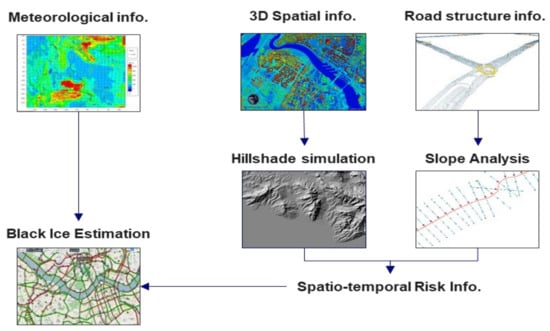
Figure 1.
The overall concept of the proposed black ice risk estimation system.
3.1. Hillshade Simulation with 3D Spatial Information
As suggested by Shao and Lister [5], spatial shade simulation on previous 3D spatial terrain information is necessary to improve black ice estimation. A national digital evaluation model (DEM) was generated at 1 m intervals with a national map on a scale of 1/5000 provided by the National Geographic Information Institute [22] and local maps on a scale of 1/1000 provided by the National Spatial Information Portal [23]. As shown in Figure 2, the two maps show contour lines that connect similar elevations. Based on the maps, DEM was generated with ArcGIS v10.1. The solid green lines represent the contour lines from the national map, whereas the shading behind these lines is the constructed DEM based on the contour lines. The high-elevation areas are brighter, whereas the low-elevation areas are relatively darker.
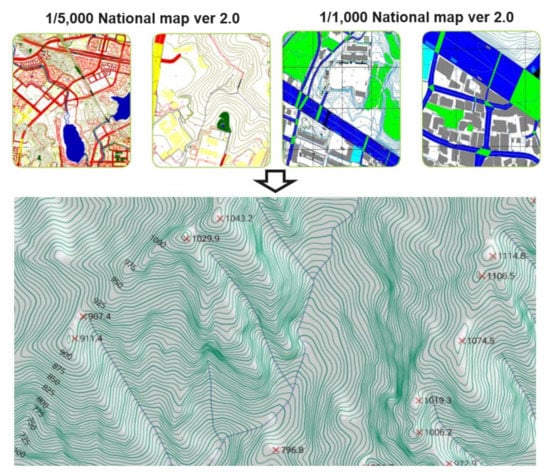
Figure 2.
Digital elevation model extracted from 1/5000 and 1/1000 national map ver 2.0.
The altitude and azimuth angles are required to detect areas with shadows at specific times of the day using the DEM. Therefore, this information is developed using data from the Korea Astronomy and Space Science Institute (KASCI) [24]. The KASCI provides hourly information on the altitude and azimuth angles of the sun, along with sunrise and sunset times at a specific place and time, in the form of graphs and tables (Figure 3).
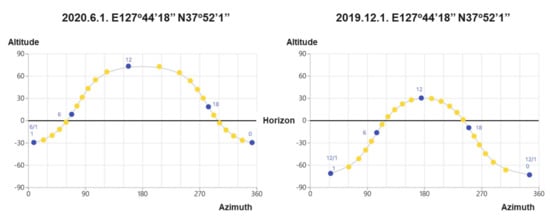
Figure 3.
Altitude and azimuth angles of the sun in Korea.
Shadow occurrences can be simulated by using the hillshade analysis function in ArcGIS and analyzing the DEM information with the altitude and azimuth angles of the sun (Figure 4). The results of the simulated shadow occurrences at 07:00, 09:00, and 11:00 (i.e., after sunrise) on 1 March 2020, are shown in Figure 4.
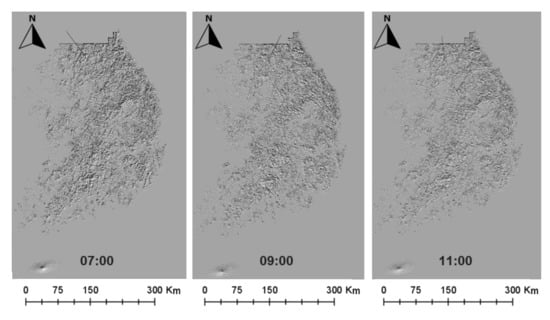
Figure 4.
Hillshade simulation with 3D spatial information.
3.2. Slope and Curvature Analysis with Road Structure Information
The slope of roads is one of the critical factors in assessing the risk of traffic accidents caused by black ice [25]. It is certainly difficult to stop in road segments with sharp turns covered with black ice; therefore, major accidents may occur. For this reason, we created a road network to estimate the slope and curvature of roads in Korea, as shown in Figure 5. The related information and maps for the current highways and national roads were extracted from the Road Management System (RMS). Figure 6 shows an example of the slope information collected from the RMS.
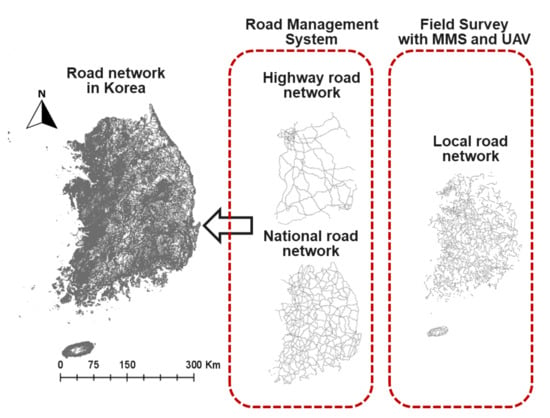
Figure 5.
The full road network data of Korea obtained from Road Management System (RMS) and field surveys.
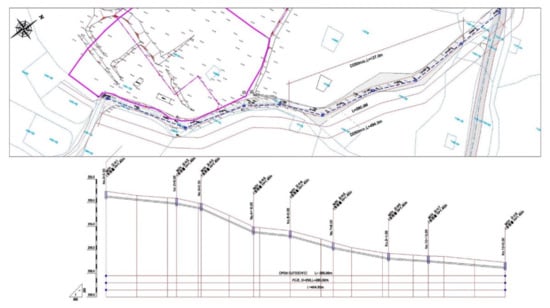
Figure 6.
An example of the slope information collected from the Road Management System (RMS).
In contrast, roads maintained by local governments are not managed by the RMS. Consequently, field surveys were necessary to obtain road structure information. In preparation for new innovations such as autonomous driving, the government has been building 3D spatial information using mobile mapping systems on some urban roads. Therefore, relevant information about the local roads in unpopular (i.e., for tourism) mountain areas is missing. To address this problem, we obtained the spatial data for segmentation of the roads using an unmanned aerial vehicle (UAV) (Figure 7). Recently, South Korea’s national land development corporations have been actively advocating for the establishment of spatial information using UAVs. Public enterprises in Korea, such as Korea Expressway Corporation and Korean Land and Infomatix Corporation, have established UAV imaging platforms and actively promote image-based spatial data construction and measurement [26]. Such data are useful for generating precise 2D orthomosaic images and 3D geospatial data (see Figure 7) and estimating slope angles of various road segments by overlaying the road network data generated from RMS. The orthoimages and 3D models were generated by Pix4D Mapper 4.0, and the DSMs were created by ContextCapture 4.0. In this study, a fixed-wing UAV, sensyFly ebee X was mainly used to take images along road segments, and the resolution of the 3D models and DSMs was 10 cm.
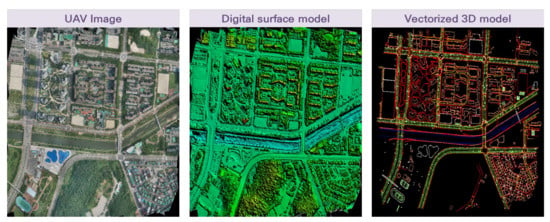
Figure 7.
Ortho-rectified image (left), digital surface model (middle), and 3D model (right) obtained by UAV.
3.3. Black Ice Risk Estimation with Meteorological Information
This study applied the black ice risk estimation model, which is based on the algorithm proposed by Kim et al. [19]. Among the traffic accidents that occurred in 2015, investigations of the weather conditions at the accident sites (related to freezing rain or black ice) revealed that they mostly occurred on a warm front or a low-pressure front with the presence of a temperature inversion layer. This is consistent with the usual meteorological pattern that causes freezing rain. Subsequently, an estimation model that considers variables such as the freezing level, temperature, wind speed, and humidity was proposed (Figure 8). Although it is necessary to apply a more sophisticated model to predict black ice, this study applied a relatively simple estimation model as the primary objective was to link meteorological information with spatial information.
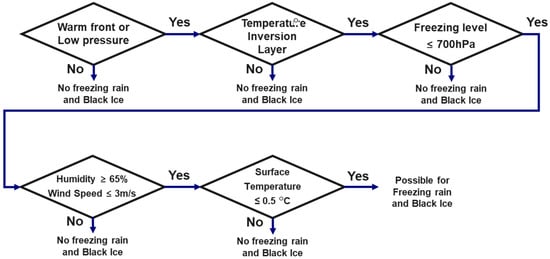
Figure 8.
Black ice risk estimation model used in the study.
Generally, meteorological variables are used to explain and predict road surface conditions. Currently, meteorological information in South Korea is collected using AWS, ASOS, and RWIS (Table 1). However, AWS, which is a device for detecting hazardous local weather patterns, lacks data on snowfall amounts, whereas the diverse meteorological information collected by ASOS is irrelevant for the roads. On some of the highways, RWIS installed a system for collecting, processing, and utilizing meteorological information in real-time, i.e., specific for road management. Currently, such meteorological information can be collected using Open-API functions of the web services operated by the Korea Meteorological Agency (KMA). Our system collected comprehensive weather data from KMA in real-time.

Table 1.
Features of weather observation equipment.
3.4. Traffic Accident Risk Estimation
The estimation model demonstrated in Section 3.3 can predict the probability of black ice formation from freezing rain at the locations where AWS and ASOS are installed. However, as listed in Table 1, there are about 1500 locations nationwide where these devices are installed, thereby making it impossible to apply the model to individual sections of the roads. Therefore, this model can be used to provide hazard information over vast regions, i.e., similar to weather forecasts. The information can be used for response planning by local road management organizations rather than by individual drivers. In this study, shaded areas were extracted from road segments, at the time of black ice warning issuance, based on the results from hillshade simulation analysis. Further, the segments with a slope angle of ≥5° were extracted to determine hazardous locations.
4. Results
Figure 9 shows the system architecture of the proposed method that combines meteorological, spatial, and road structure information. First, the spatial information required for the hillshade simulation was acquired using the web portal of the National Spatial Data Infrastructure (operated by the Ministry of Land, Infrastructure, and Transport) [23]. The altitude angle and azimuth angle of the sun, required for the shade analysis per time zone, were acquired from the portal operated by KASCI. The structure information required for calculating the slope angle of a road was obtained from RMS. Currently, the system does not provide API functions for data delivery, thereby requiring the user to directly search for the necessary information. However, KMA’s web service provides Open-API functions, which enable an automatic collection of weather information for a specific location and time. The collected data was integrated into ArcGIS v10.1. The analysis was conducted using the method proposed in this study.
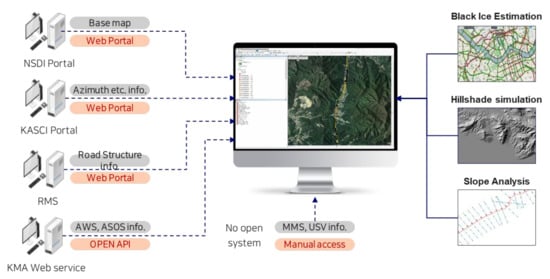
Figure 9.
System architecture of the proposed method.
The proposed black ice estimation system was tested on two 50 km by 50 km regions, which was the testing area around Sokcho, Gangwon-do. The road segments in the testing areas were resampled every 50 m because the length of the road section for slope estimation provided by RMS was 50 m. The proposed method was then applied for each resampled segment. Figure 10 shows the testing area and a black ice risk map estimated using weather, surrounding terrain, and road structure information for March 1 2020, at 09:00. As shown in Figure 4, the northeastern area of Korea is usually a mountainous area and is close to the East Sea. Therefore, humidity is high in winter, frequently causing weather phenomena such as fog, and the temperature is low in the morning with significant daily temperature variations, thereby increasing the risk of the occurrence of black ice. Consequently, the estimation based exclusively on meteorological information resulted in possible black ice formation in all the road segments. However, the results do not provide specific road safety and warning information for drivers. Therefore, a hazard warning sign was installed, based on previous traffic accidents, to inform drivers about the hazard.
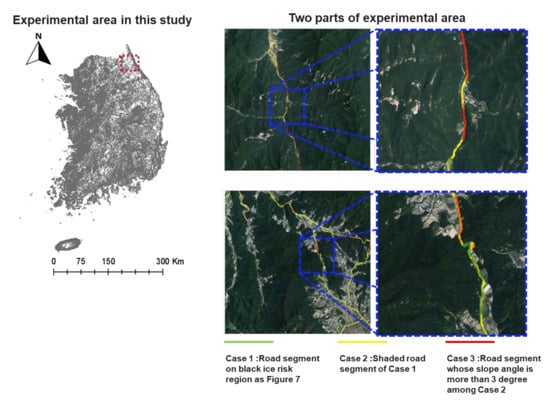
Figure 10.
The testing area used in this study.
The application of the proposed method resulted in a more specific identification of segments where thawing by solar heat was limited by shadows at certain times (see Case 2, Figure 10). Further, segments with a high risk of slipping when stopping a vehicle (Case 3) could be determined by considering the slope angle of each road segment. A comparison of the results with the terrain shades indicates that, even on the same road segment, there may be a significant difference in the likelihood of black ice formation. The effect of shadows was pronounced in the upper cases where the road profile was relatively simple, whereas a combination of Cases 1, 2, and 3 was present in the lower cases where the road profile was relatively complex. In the latter cases, the possibility of an occurrence of a slide accident was high, as a vehicle could shift onto a segment covered with black ice at a regular speed from an ice-free segment of the road. In this study, it was confirmed that these local risk areas could not be detected using the existing estimation model that only relies on meteorological information to predict black ice formation across a vast region. However, its combination with geographic information yielded better detection results.
According to the proposed method, geospatial simulation with meteorological, spatial, and road structure information was executed for two years (from 2017 to 2018). As a result, the proposed method estimated 468 black ice road segments. There were 73 traffic accidents within the two test regions due to black ice during the testing period, and 52 of them occurred within the Case 3 segments, and 15 of them occurred within the Case 2 segments. That is, 71% of black ice traffic accidents could be anticipated by the proposed method. It was a sufficient achievement to use the existing information resources and geospatial information for the purpose of preventing accidents by estimating and warning of the risk of black ice.
5. Discussion
As described in the previous chapter, our black ice risk assessment system anticipated 71% of black-ice-related traffic accidents based on meteorological, spatial, and road structure information. That is to say, if the system had been in operation during the testing period, precautionary practices or warnings could have been established for 71% of accidents. This result has significance in that our system can prepare a preventive measure for black-ice-related traffic accidents occurring on local roads. This is because, unlike other existing systems that deal with relatively large regional units due to the sparse distribution of the observation equipment, the proposed system used local road management systems and local topographic maps. In addition, our system enabled localized special treatment as it segmented the road into three cases according to the possibility of black ice formation based on real-time hillshade.
The black-ice-related issues are mainly addressed in countries that have specific regional and climatic characteristics. However, the fatality rate of black ice in traffic accidents is much higher than that of snow in those countries. According to the Korea Transport Institute, the number of deaths from traffic accidents caused by black ice was 170 from 2015 to 2019, which is far higher than that of traffic accidents caused by snow (46 people), as shown in Table 2 [27]. This phenomenon is similarly found in other countries [28]. In this respect, our system is expected to contribute to reducing traffic accidents and deaths caused by black ice in countries with similar climatic and topographical conditions to Korea.

Table 2.
Traffic accident statistics by road condition.
6. Conclusions
In this study, a method to estimate black ice risk regions along the mountain roads was proposed, considering South Korea’s geographical and meteorological characteristics. To achieve this, we estimated the areas prone to black ice formation with limited thawing after sunrise by using the hourly shade and terrain information. Afterward, the specific risk segments were detected by considering the slope angle of the roads. The proposed system was tested in two regions where black ice occurs frequently. The results confirmed that the risk levels vary with the surrounding terrain even on the same road segment; thus, they additionally verified the likelihood of subsequent traffic accidents. Moreover, the proposed system anticipated 71% of traffic accidents caused by black ice during the testing period. The results show that the system can contribute significantly to preventing black-ice-related traffic accidents.
The current study had certain limitations. For example, we exclusively considered the effects of shade brought by the adjacent terrains, whereas other shade effects from road facilities, such as soundproof walls and tunnels, were not considered. Moreover, several studies have reported significant shade effects over the bridges in the absence of geothermal heat, which was not reflected in this study. Additional data for evaluating the accuracy of the proposed method are required. However, with increasing public interest in black ice and the initial stage of establishing relevant data, the visual and qualitative assessments performed in this study are plausible.
Research towards developing a real-time warning system is underway by testing vehicles equipped with sensors on high-risk roads (i.e., for black ice formation) as part of the recent response to black ice. Combining meteorological, terrain, and sensor information and data-driven analytical techniques such as machine learning or deep learning should enable more accurate predictions and warning systems in the future. The results of this study will be used for real-time prioritization of the target regions during the operation of survey vehicles.
Author Contributions
Conceptualization, J.-K.L.; methodology, J.-K.L. and Y.H.; software and data analysis, J.-K.L., Y.H. and J.P.; data curation, J.P.; writing—original draft preparation, J.-K.L.; writing—review and editing, Y.H. and J.P. All authors have read and agreed to the published version of the manuscript.
Funding
This work was supported by the Korea Institute of Civil Engineering and Building Technology Research Project (Research on Smart Construction Technology for Leading the future construction industry and Creating new market) [2022].
Institutional Review Board Statement
Not applicable.
Informed Consent Statement
Not applicable.
Data Availability Statement
Not applicable.
Conflicts of Interest
The authors declare no conflict of interest.
References
- Kim, I.; Bae, I.; Rhee, J.; Jang, H.; Kim, K. Pavement Management Strategy for Traffic Safety in Winter Season; Korea Expressway Corporation Research Institute: Hwasung-si, Korea, 2016. [Google Scholar]
- Liu, T.; Wang, N.; Yu, H.; Basara, J.; Hong, Y.; Bukkapatnam, S. Black Ice Detection and Road Closure Control System for Oklahoma; Oklahoma Department of Transportation: Oklahoma City, OK, USA, 2014; pp. 1–2. [Google Scholar]
- Kim, S.; Jang, Y.; Kim, S.; Min, D.; Na, H.; Choi, J. A Study on the effects of factors of traffic accidents caused by frozen urban road surfaces in the winter. Int. J. Highw. Eng. 2015, 17, 79–87. [Google Scholar] [CrossRef]
- Korea Transport Institute. Black Ice Traffic Accident. 2021. Available online: https://english.koti.re.kr/user/bbs/BD_selectBbs.do?q_bbsCode=1106&q_bbscttSn=20210419103506524 (accessed on 23 May 2022).
- Lee, D.; Jeong, W.; Kim, H.; Kim, J. Study about the evaluation of freezing risk-based road surface of solar radiation. J. Korea Inst. Struct. Maint. Insp. 2018, 17, 130–135. [Google Scholar] [CrossRef][Green Version]
- Shao, J.; Lister, P. An automated nowcasting model of road surface temperature and state for winter road maintenance. J. Appl. Meteorol. 1996, 35, 1352–1361. [Google Scholar] [CrossRef]
- Sass, B. A numerical forecasting system for the prediction of slippery roads. J. Appl. Meteorol. 1997, 36, 801–817. [Google Scholar] [CrossRef]
- Crevier, L.; Delage, Y. METRo: A new model for road-condition forecasting in Canada. J. Appl. Meteorol. 2001, 40, 2026–2037. [Google Scholar] [CrossRef]
- Kim, H. Development of a road hazard map considering meteorological factors. J. Korean Soc. Surv. Geod. Photogramm. Cartogr. 2017, 35, 133–144. [Google Scholar]
- Ishikawa, N.; Narita, H.; Kajiya, H. Contributions of heat from traffic vehicles to Snow melting on roads. Transp. Res. Rec. 1999, 1672, 28–33. [Google Scholar] [CrossRef]
- Fujimoto, A.; Saida, A.; Fukuhara, T. A New Approach to Modeling Vehicle-Induced Heat and Its Thermal Effects on Road Surface Temperature. J. Appl. Meteorol. Climatol. 2012, 51, 1980–1993. [Google Scholar] [CrossRef]
- Fujimoto, A.; Tokunaga, R.; Kiriishia, M.; Kawabata, Y.; Takahashi, N.; Ishida, T.; Fukuhara, T. A road surface freezing model using heat, water and salt balance and its validation by field experiments. Cold Reg. Sci. Technol. 2014, 106–107, 1–10. [Google Scholar] [CrossRef]
- Krsmanc, R.; Slak, A.; Carman, S. Next steps in forecasting road surface temperature and developing MDSS. In Proceedings of the International Symposium on Electronics in Transport 2011, Ljubljana, Slovenia, 28–29 March 2011. [Google Scholar]
- Liu, T.; Pan, Q.; Sanchez, J.; Sun, S.; Wang, N.; Yu, H. Prototype Decision Support System for Black Ice Detection and Road Closure Control. IEEE Intell. Transp. Syst. Mag. 2017, 9, 91–102. [Google Scholar] [CrossRef]
- Fowler, J.W.; Jin, M.S.; Bauer, B.A.; Naylor, J.R. Icy Road Forecast and Alert (ICYROAD): Validation and Refinement Using MDT RWIS Data; Montana Department of Transportation: Helena, MT, USA, 2022. [Google Scholar]
- Venkat, A.; KP, G.V.; Thomas, I.S.; Ranjani, D. Machine Learning Based Analysis for Road Accident Prediction. Int. J. Emerg. Technol. Innov. Eng. 2020, 6, 31–37. [Google Scholar]
- Schlogl, M. A multivariate analysis of environmental effects on road accident occurrence using a balanced bagging approach. Accid. Anal. Prev. 2020, 136, 105398. [Google Scholar] [CrossRef] [PubMed]
- Malin, F.; Norros, I.; Innamaa, S. Accident risk of road and weather conditions on different road types. Accid. Anal. Prev. 2019, 122, 181–188. [Google Scholar] [CrossRef] [PubMed]
- Kim, D.; Yoon, S.; Kim, B. Comparison of spatial interpolation methods for producing road weather information in winter. J. Korean Data Anal. Soc. 2020, 23, 541–551. [Google Scholar] [CrossRef]
- Kim, D.; Jung, S.; Yoon, S. Risk Prediction for Winter Road Accidents on Expressways. Appl. Sci. 2021, 11, 9534. [Google Scholar] [CrossRef]
- Eugster, W.J. Road and bridge heating using geothermal energy. Overview and examples. In Proceedings of the European Geothermal Congress (2007), Unterhaching, Germany, 30 May–1 June 2007. [Google Scholar]
- National Geographic Information Institute. Map of Korea. Available online: https://www.ngii.go.kr/eng/content.do?sq=103 (accessed on 23 May 2022).
- National Spatial Information Portal. Map Service. Available online: http://www.nsdi.go.kr/lxmap/index.do (accessed on 23 May 2022).
- Korea Astronomy and Space Science Institute. Sunset/Sunrise Time Calculator. Available online: https://astro.kasi.re.kr/life/pageView/9 (accessed on 23 May 2022).
- Call, D.A.; Medina, R.M.; Black, A.W. Causes of weather-related crashes in Salt Lake County, Utah. Prof. Geogr. 2019, 71, 253–264. [Google Scholar] [CrossRef]
- Cho, J.W.; Lee, J.K.; Park, J. Large-Scale Earthwork Progress Digitalization Practices Using Series of 3D Models Generated from UAS Images. Drones 2021, 5, 147. [Google Scholar] [CrossRef]
- Korea Road Traffic Authority. Traffic Accident Analysis System. Available online: http://taas.koroad.or.kr/sta/acs/exs/typical.do?menuId=WEB_KMP_OVT_UAS_ASA (accessed on 23 May 2022).
- Takahashi, N.; Tokunaga, R. A field experiment on the accuracy of visual assessment of winter road conditions. In Proceedings of the 18th International Conference Road Safety on Five Continents (RS5C 2018), Jeju Island, Korea, 16–18 May 2018. [Google Scholar]
Publisher’s Note: MDPI stays neutral with regard to jurisdictional claims in published maps and institutional affiliations. |
© 2022 by the authors. Licensee MDPI, Basel, Switzerland. This article is an open access article distributed under the terms and conditions of the Creative Commons Attribution (CC BY) license (https://creativecommons.org/licenses/by/4.0/).